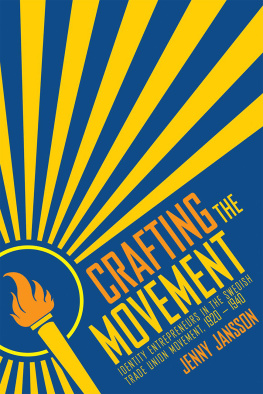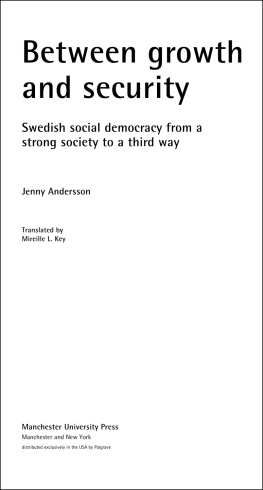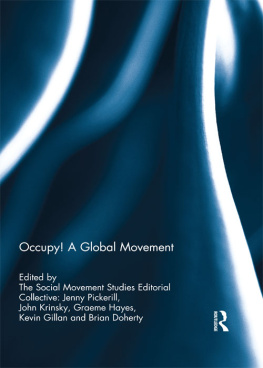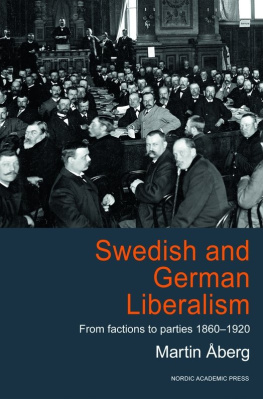CRAFTING THE MOVEMENT
Identity Entrepreneurs in the Swedish Trade Union Movement, 19201940
Jenny Jansson
ILR PRESS
AN IMPRINT OF CORNELL UNIVERSITY PRESS ITHACA AND LONDON
To Anneli and Mats
Contents
Acknowledgments
I have received many helpful comments from colleagues on early versions of this book. In particular, I thank Jrgen Hermansson, Markus Holdo, Silke Neunsinger, Hilary Orange, Bo Rothstein, Jonas Sderqvist, Johanna Sderstrm, Katrin Uba, PerOla berg, and the two anonymous reviewers for their comments, advice, and support.
I also thank my wonderful colleagues at the Institute for Social Movements at Ruhr-Universitt Bochum for offering me a great environment in which to finish the book and Stefan Berger for facilitating my stay in Bochum. A special thanks to the Library of the Ruhr and its helpful staff.
Without the Swedish Labour Movements Archive and Library in Stockholm and its enthusiastic and knowledgeable staff it would have been difficult to write this bookthank you all.
I am also very grateful for the funding from the Swedish Research Council and the Swedish Foundation for Humanities and Social Sciences that supported the writing of this book.
Finally, to my parents, Anneli and Matsthank you for your never-ending encouragement.
Abbreviations
ABF Arbetarnas bildningsfrbund (Workers Educational Association)
FPF Fackliga propagandafrbundet (Trade Union Propaganda League)
IOGT International Organization of Good Templars
KF Kooperativa frbundet (Cooperative Union)
KUF Kommunistiska Ungdomsfrbundet (Communist Youth League)
LO Landsorganisationen (Trade Union Confederation)
NOV Nykterhetsorganisationen Verdandi (Temperance Organization Verdandi)
SAC Sveriges arbetares centralorganisation (Central Organization of the Workers of Sweden)
SAF Svenska arbetsgivarefreningen (Swedish Employers Association)
SAP Socialdemokratiska arbetarpartiet (Social Democratic Party)
SDU Socialdemokratiska ungdomsfrbundet (Social Democratic Youth Organization, 190317)
SDUK Socialdemokratiska ungdomsklubben (Social Democratic Youth Club) This was the most common name of the local associations of SDU. After the party split in 1917, some of the local youth associations kept their original name even though the correct name after 1917 is SSU.
SKP Sveriges kommunistiska parti (Communist Party of Sweden, 19211967)
SSU Sveriges socialdemokratiska ungdomsfrbund (Swedish Social Democratic Youth League, 1917)
SSV Socialdemokratiska vnsterpartiet (Social Democratic Left Party, 19171921, referred to as the Left Party)
SUF Socialistiska ungdomsfrbundet (Socialist Youth League, also known as the Young Socialists)
SUP Sveriges ungsocialistiska parti (Swedish Young Socialist Party)
THE REFORMIST CHOICE
The Swedish reformist labor movement of the twentieth century constitutes a success story. A strong Social Democratic PartySocialdemokratiska arbetarpartiet (SAP)and high union density paved the way for an extensive and comprehensive welfare state and diminishing wage inequality. One key component of the dominance of Swedish social democracy was the labor movements extraordinary ability to mobilize the majority of the working class early on in its mission. In what may have been the most challenging period for social democracythe interwar periodreformist labor organizations managed to establish reformism and a unique spirit of negotiation on a broad basis, thereby creating a cohesive movement. Why did the reformist branch receive such widespread support when other European labor movements were riven by internal disputes? It is inarguable that in the aftermath of the First World War, Europe was swept by a wave of labor movement radicalization. The war, which itself had mobilized mass protests, particularly by left-wing groups, challenged social democracy, as social democratic parties had accepted democracy and therefore often cooperated with bourgeois governments during the war. Internal disputes arose from ideological splits in the labor movement. The orthodox Marxism advocated by Karl Kautsky and the German Social Democrats (Sozialdemokratische Partei Deutschlands; SPD) was criticized for its passivity, with criticism coming from the revisionists, of whom Eduard Bernstein was the main proponent, and the revolutionary branch, headed by Vladimir I. Lenin. Both argued that Marx and Engelss predictions of the capitalist systems imminent breakdown and the predetermined takeover by the masses were not going to come true. There were no signs of a breakdown of the capitalist system. In that case, they queried, should workers simply wait for history to take its course, or should positive action be taken?
The recession that followed the war and resulted in high unemployment hit most European countries hard and fostered radical proposals for how to bring about socialism. New left-wing factions arose and challenged social democracy, questioning its ability to realize socialism. Other less prudent and more rapid approaches suddenly appealed to the workers. It became harder for the more moderate reformist labor movement to attract the masses because revolution appeared to be a quick fix for achieving socialism.
Amid this situation, in 1917, the radical left wing of the Russian labor movement under the leadership of Lenin transformed revolutionary slogans into reality. The Russian Revolution, which embodied a radical revision of Marxism, changed the labor movement on a global scale and sparked radicalization. This long-awaited revolution acted as a rallying point for radical groups. Shortly afterward, inspired by the events in Russia, Rosa Luxemburg and Karl Liebknecht, following Lenins lead, attempted to start a revolution in war-torn Germany in 1919. The Spartakusbund was brutally crushed by the army, as sanctioned by the SPD, creating an unbridgeable cleavage between the social democrats and left-wing Germans. The failure of Luxemburgs revolutionary efforts was only one of many such failures to come.
The revolutionary ideas emanating from the Russian Revolution provoked counteractions from right-wing parties and conservatives. In Italy, the labor movements radicalization after the war resulted in numerous strikes and eventually paved the way for the Fascists and Mussolini to seize power (Bell 1984; Berman 2006, 12630). In Austria, the radicalization of the labor movement, which had been strong and stable, resulted in a dictatorship when Engelbert Dollfuss took charge in 1933 (Cronin 1980; Wasserman 2014). In Spain, several socialist parties struggled for power. When the socialist coalition Frente Popular came into power in 1936, it pursued a range of reforms, provoking a counter-revolution that brought General Franco to power (Lapuente and Rothstein 2014). Many other examples follow the same pattern. After 1917, the labor movement split between communists, social democrats, and syndicalists. In the worst instances, backlash to radicalization resulted in dictatorships or authoritarian governments, whereas in cases such as France (Bartolini 2000, 1078) it weakened the labor movement considerably. Instead of fighting together against the Right and the capitalist class, the communists, social democrats, and syndicalists fought with each other, wasting resources and energy, making it difficult to influence politics and in the long run to effectively mobilize the working class.
In 1917, the next setback for the reformist labor movement arrived. The SAP, in which different factions had coexisted, split into two parties when the youth organization decided to go its own way and founded what a few years later would become the Communist Party. These events all pointed in the same direction: Sweden was heading down the same road as the rest of Europe, toward a divided labor movement in which factions would fight each other rather than join forces against employers and right-wing political parties.









